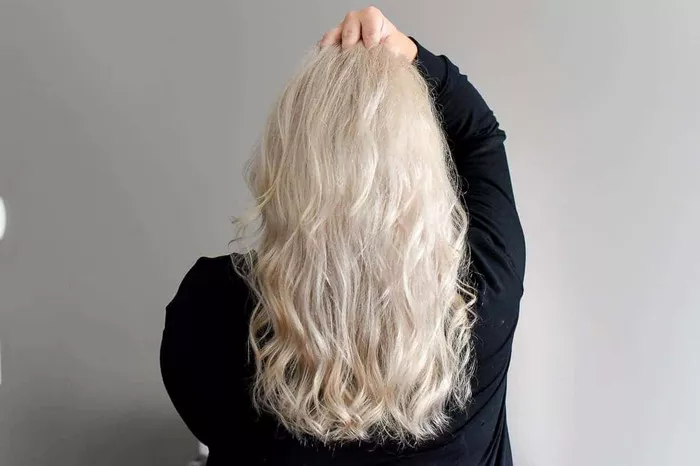Bleached hair is a blank canvas for creativity. After bleaching, your hair loses its natural pigment, becoming pale yellow or white. This process opens the hair cuticle, making it more porous and fragile. Choosing the right dye is critical to achieve your desired color while keeping your hair healthy. This essay will explore the types of dyes suitable for bleached hair, their pros and cons, application tips, and aftercare.
Understanding Bleached Hair
Bleaching strips the hair of melanin (natural pigment) using chemicals like hydrogen peroxide. This weakens the hair structure, causing dryness and porosity. Porous hair absorbs color quickly but struggles to retain it. The goal when dyeing bleached hair is to:
- Enhance vibrancy (light hair shows bright colors better).
- Minimize damage (avoid harsh chemicals).
- Extend color longevity (porous hair fades faster).
Before dyeing, assess your hair’s health. If it feels gummy or breaks easily, focus on repair (deep conditioning, protein treatments) before adding color.
Types of Dyes for Bleached Hair
Semi-Permanent Dye
- What It Is: A non-damaging color that coats the hair shaft without penetrating deeply. No developer (peroxide) is needed.
- Best For: Bold fashion colors (pink, blue, purple), pastels, or temporary changes.
- Popular Brands: Arctic Fox, Manic Panic, Adore.
Pros:
- Zero damage (no ammonia or peroxide).
- Fades gradually, allowing easy color changes.
- Conditions hair (many contain moisturizing ingredients).
Cons:
- Lasts 4–8 washes.
- May stain towels/pillows.
How to Apply:
- Shampoo hair, skip conditioner (clean hair holds color better).
- Apply dye evenly with gloves.
- Leave for 20–40 minutes; rinse with cool water.
Tips:
- Mix with conditioner to create pastels.
- Use color-depositing shampoo to refresh faded tones.
Demi-Permanent Dye
- What It Is: A low-chemical dye mixed with a mild developer (5–10% peroxide). It partially penetrates the hair shaft.
- Best For: Natural-looking shades (browns, blondes) or toning brassy hair.
- Popular Brands: Wella Color Charm, Redken Shades EQ.
Pros:
- Longer-lasting than semi-permanent (up to 24 washes).
- Adds shine and subtle dimension.
- Less damaging than permanent dye.
Cons:
- Limited to darker or tonal changes (can’t lighten hair).
- Requires developer (mild damage possible).
How to Apply:
- Mix dye and developer as directed.
- Apply to damp hair, processing for 20–30 minutes.
- Rinse thoroughly.
Tips:
- Use a purple demi-permanent dye to neutralize yellow tones in blonde hair.
Permanent Dye
- What It Is: A high-impact color that uses ammonia and high-volume developer (20–30% peroxide) to lift and deposit pigment.
- Best For: Darker shades (black, deep red) or full coverage.
- Popular Brands: L’Oréal Excellence, Garnier Nutrisse.
Pros:
- Long-lasting (until roots grow out).
- Covers gray hair effectively.
Cons:
- High damage risk (dries out bleached hair).
- Commitment (hard to remove).
How to Apply:
- Conduct a strand test first (bleached hair may react unpredictably).
- Use a “filler” (a mid-tone dye) to even out porosity before applying dark shades.
- Follow instructions carefully; avoid overlapping with previously bleached sections.
Tips:
- Opt for ammonia-free permanent dyes to reduce damage.
Temporary Color (Sprays, Chalks, Mascaras)
- What It Is: Instant color that sits on the hair’s surface. Washes out in one wash.
- Best For: Parties, events, or experimenting without commitment.
- Popular Brands: L’Oréal Color Spray, Colorista Hair Chalk.
Pros:
- No damage.
- Instant results.
Cons:
- Messy (may transfer to clothes).
- Short-lived.
How to Apply:
- Spray or rub onto dry hair.
- Avoid touching hair until event ends.
Natural Dyes (Henna, Indigo)
- What It Is: Plant-based pigments that bind to hair.
- Best For: Reds (henna) or blacks (henna + indigo).
- Popular Brands: Light Mountain, The Henna Guys.
Pros:
- Conditions hair (henna strengthens strands).
- Chemical-free.
Cons:
- Permanent (hard to remove).
- Limited color options.
How to Apply:
- Mix henna powder with water or lemon juice.
- Let sit for 12 hours to release dye.
- Apply to hair; leave for 2–4 hours.
Warning:
- Metallic salts in some hennas can react badly with chemical dyes.
Aftercare for Dyed Bleached Hair
- Wash Less Frequently: Use sulfate-free shampoo to prevent fading.
- Cold Water Rinses: Seal the hair cuticle to lock in color.
- Deep Condition Weekly: Repair damage with masks containing keratin or shea butter.
- Avoid Heat Tools: Let hair air-dry; use heat protectant if styling.
- UV Protection: Wear hats or use UV-blocking sprays to prevent sun fading.
Conclusion
Bleached hair offers endless color possibilities, but its fragile state demands careful dye selection. Semi-permanent dyes are ideal for bold, temporary looks, while demi-permanent options provide longer-lasting tonal shifts. Permanent dyes should be used sparingly due to their high damage risk. Always prioritize hair health with deep conditioning and gentle products. By understanding your options and maintaining your hair, you can enjoy vibrant, head-turning color without compromising strength.
Related topics:
10 Best Shampoos for Bleached Hair
10 Tips to Help Dry Bleached Hair
Does Bleached Hair Grow Slower?


